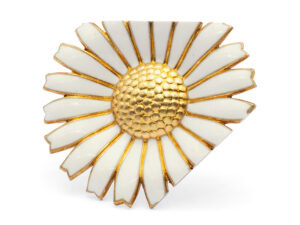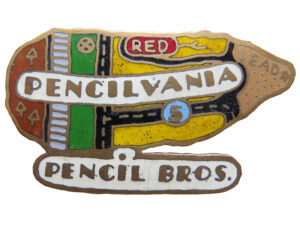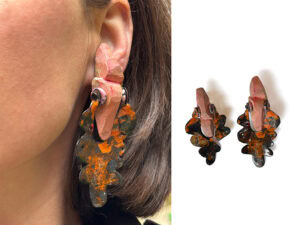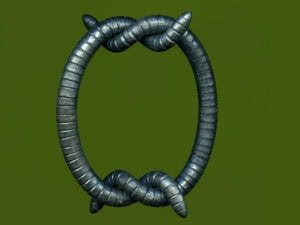
Beyond the occasional comment on a blog site, it’s rare for someone to put the effort into mounting a well-framed argument to express their disagreement. I’m naturally inclined to defend my point of view, but am grateful for the opportunity to continue an argument that will hopefully strengthen both positions.
Bruce Metcalf responded critically to an article I wrote for AJF about ethical jewelry which was recently reposted on this blog. The kind of ethics I mentioned ranged from the democratic values involved in the critique of preciousness to Ethical Metalsmiths that recruit practice to environmental sustainability.
Ethics is a particularly sensitive subject for jewelry. Jewelry seems to be a medium we set aside from more weighty matters for the enjoyment of frivolity, irony and dazzlement. Expecting moral rectitude from jewelry can appear like throwing a wet blanket on a rare space of innocent play.
Yet we are aware also of monsters lurking in the woods. Jewelry has a profoundly undemocratic history, serving to prop up the aristocratic and military one percent. Stories about ‘blood diamonds’ suggest the trail human and environmental destruction that leads to breakfast at Tiffany’s.

Beyond the occasional comment on a blog site, it’s rare for someone to put the effort into mounting a well-framed argument to express their disagreement. I’m naturally inclined to defend my point of view, but am grateful for the opportunity to continue an argument that will hopefully strengthen both positions.
Bruce Metcalf responded critically to an article I wrote for AJF about ethical jewelry which was recently reposted on this blog. The kind of ethics I mentioned ranged from the democratic values involved in the critique of preciousness to Ethical Metalsmiths that recruit practice to environmental sustainability.
Ethics is a particularly sensitive subject for jewelry. Jewelry seems to be a medium we set aside from more weighty matters for the enjoyment of frivolity, irony and dazzlement. Expecting moral rectitude from jewelry can appear like throwing a wet blanket on a rare space of innocent play.
Yet we are aware also of monsters lurking in the woods. Jewelry has a profoundly undemocratic history, serving to prop up the aristocratic and military one percent. Stories about ‘blood diamonds’ suggest the trail human and environmental destruction that leads to breakfast at Tiffany’s.
How do we reconcile the light and dark sides of jewelry?
Bruce Metcalf is on the side of light and freedom. He saw me as hectoring him to do something he didn’t want to, or at least didn’t want to be told to do. For Metcalf, this threatened his freedom as an artist: ‘The history of modern art is the history of artistic freedom, of the artist’s hard-earned right to do precisely what he deems necessary.’
The easy way out of this is say that I was not attempting to limit the range of artistic practice, but rather to extend the concept of contemporary jewelry to include the social dimension. It can encompass not only works of personal expression, but also wearable objects that connect people together for various ends.
But personally, I would probably go further than that. While not wanting to constrain the formal development of the field, I think we should have capacity to critique all work on ethical grounds. If a work celebrates wonton excess, the degradation of women or racism, then its message should be open to criticism. This does not cancel out the aesthetic dimension. Noting the complicity of Socrates in the oppression of women and slaves does not annul our estimation of his contribution to Western philosophy. But it does alert us to potential limits in his vision. Ethics helps us at least identify boundary conditions of practice.
But let’s go back to the first point. Can ethics be a subject of contemporary jewelry? Metcalf plainly believes this is possible, but only within an individual conscience. He invokes Arthur Danto to advocate for the private gesture:
‘. . . we can act in a way that assumes the world is exactly as we would want it to be. For instance, we could take an activist position against racial bias by refusing to ever act in a prejudiced manner. The refusal is a private matter, and may never be noticed in the larger world. But it is still essentially ethical, and stands as a critique of the corruption of the wider world.’
There are echoes of Gandhi here – ‘Be the change you want to see.’ When faced with limited opportunities for collective action, begin the political agenda with yourself.
But Gandhi still wrote books, organized political parties, engaged in the broader field. He did what he could. Making a statement in an art gallery is not nothing. The audience, though small, is more likely to have access to power than the local 7/11 store. But jewelry does have an exceptional capacity to circulate in the world beyond the gallery.
Metcalf does acknowledge the capacity of broader change in the case of the AIDS quilt. But he is rather defeatist about the potential for jewelry to be similarly effective – ‘it’s sheer fantasy to think that studio jewelry can be an effective tool for political reform.’
This is based on a very limited view of what jewelry can do. Think about the Make Poverty History bracelet. The three ‘white band’ days in the UK included eight million people wearing the same silicon wristband. The campaign led to the adoption of the Millennium Goals at the G8 Summit of world leaders in Gleneagles. This kind of activist jewelry contributed to lifting millions out of poverty. Contemporary jewelry has potential to draw on this viral power in proposing other devices for collective action.

Social jewelry is currently an area of great innovation in our field. The Radical Jewelry Makeover series by Ethical Metalsmiths does open new possibilities for the jeweler. Down where I come from is bursting with new jewelry artists and collectives that draw on the street for inspiration, challenging dominant powers in clever and playful ways. Caz Guiney’s City Rings project, where she placed gold ornament in city buildings, caused national public uproar, radically exposing our denigration of public space. Roseanne Bartley’s Culturing the Body distributed tags for people to wear with politically charged words such as ‘queue jumper’ and ‘unAustralian,’ diffusing racist epithets.
These are not dull programmatic campaigns. They combine a subtle knowledge of the social power in body ornament with creative sparks of intervention.
Maybe it’s time to broaden our understanding of the contemporary jeweler. Let’s scan the main roles, moving from internal to external focus.
- The artist is a seeker of truth.
- The maker expresses themselves through handmade goods.
- The craftsperson sustains traditions of skillfully working materials.
- The designer seeks original and effective interventions into everyday life.
- The activist subsumes their work to a political end.
It is tempting to presuppose that as one descends further down this list, aesthetic freedoms and originality are subsumed to programmatic ends.
But I’d argue that there’s a new mode of practice emerging that seeks original forms of jewelry that can operate outside the gallery. This goes beyond Craftivism. We’ve had the makers practicing what Metcalf describes as ‘alt-craft’ developing local markets for crafted goods. While potentially inventive in techniques, their products tend to be handmade versions of otherwise commodified products, such as cushion covers or coffee mugs. There now seems a broadening scope for those ‘social designers’ whose key aim is to find ways of connecting people to collectivities outside consumerism.
In Read My Pins, Madeleine Albright reflects on the purchase of jewelry made by Stefanie Rahmstorf featuring the letter C and two pearls for the Os of CO2. This pin offered a witty reference to the carbon that threatens to severely damage our future. But it also combined a symbolic gesture with promise of actual change. The sale price of each of these pins contributes to the retirement of one ton of CO2 from the atmosphere, using the European Union Emissions Trading System. Gabriel Craig uses this as an example of the ‘new craftivism’ heralding a new political awareness in craft practice.
The street has been the scene of much innovation. Take the case of the ubiquitous friendship bracelet. Originally from Brazil, these simple braided bracelets have emerged to help forge longer-term relationships. They embody not only the time required by the giver to make these objects, but also the commitment by the wearer not to remove the bracelet until it falls off naturally. It seems no coincidence that this street ritual has emerged alongside the rise of Facebook as a one-stop shop for social interaction. While marvelous for the accumulation of relationships, there’s little potential to express deeper connections. Jewelry today has potential to recover much of the personal commitment lost through the facile world of online links.
Social jewelry reflects the ‘relational turn’ that has a broad impact across the arts. The focus shifts from the isolated art object to the kind of audience it enables. Relational art does not itself guarantee ethics. While defying artistic conventions, Rikrit Tiravanija’s gallery meals did not expand his audience beyond the contemporary art world. But the relational turn does open up the power of jewelry to forge social connections. The challenge of our age is to transform those connections from the hierarchies of the past to the solidarities of the future.
This should be a path that opens new possibilities for contemporary jewelry. The same level of original thinking that produced necklaces made from a laminated photograph can be directed towards the way jewelry circulates through our world and in the process forges new structures.
Ethics isn’t set in stone, or diamonds.






